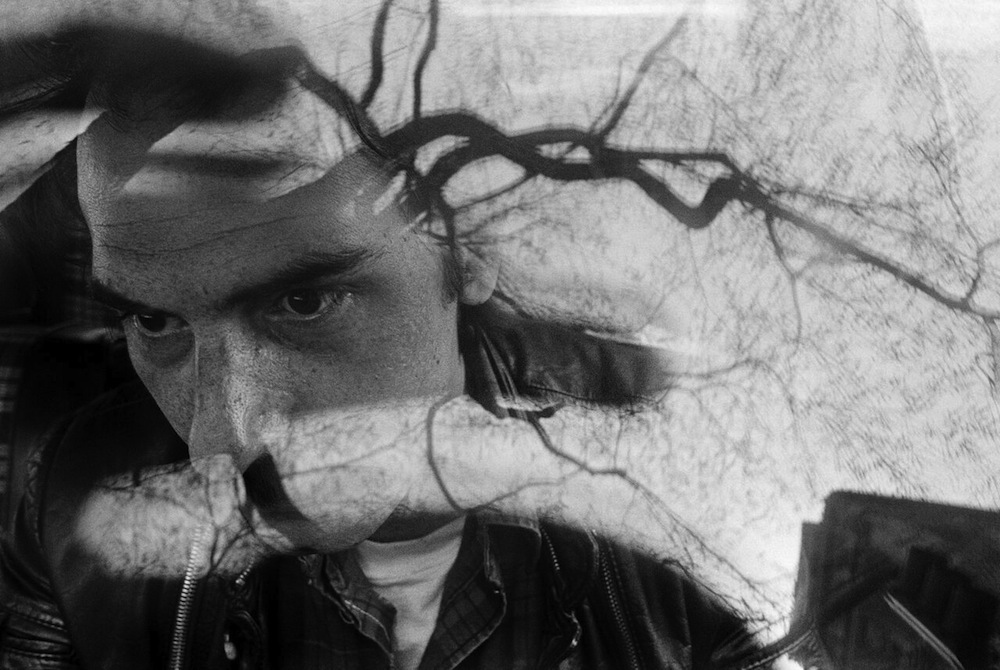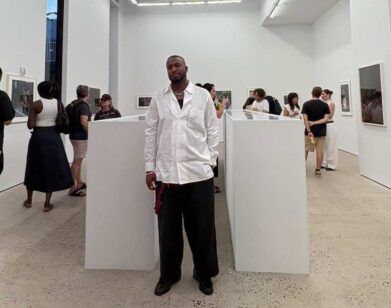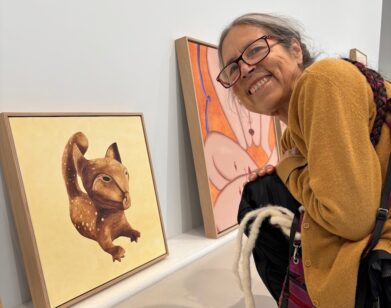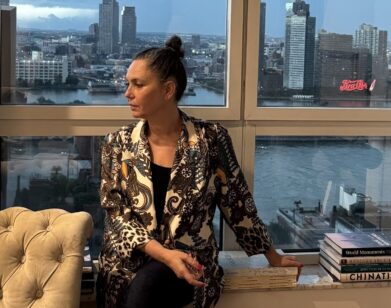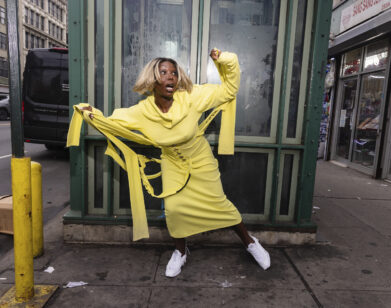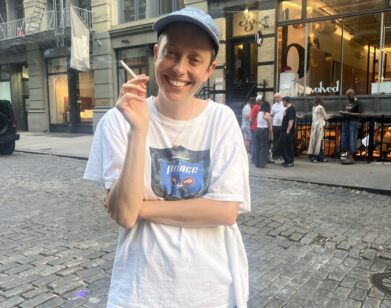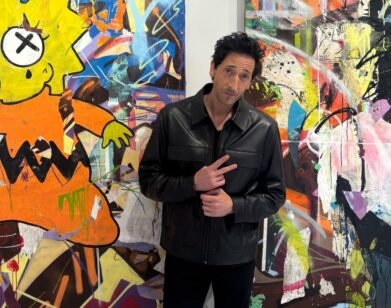Eugene Richards and American Poverty
Eugene Richards combines photographs and written personal narratives, forcing the viewer to face the realities of those living under the poverty line. The hugely influential documentary photographer from Dorchester, Massachusetts has created work that addresses issues of income inequality since he began his career in the 1970s. His latest exhibition, “Below the Line: Living Poor in America,” which opened over the weekend at the Bronx Documentary Center in New York, revisits images that Richards shot 30 years ago (which were first published in his 1987 book by the same name).
Those depicted are given due time and attention. In High on crack, New York City (1986), a man named John stares wide-eyed through a car window, the reflection of a tree branch obscuring him slightly, seemingly emerging from him. In accompanying text, he describes in his own words how he survives New York City while homeless. Another image, The farmer Ralph Timmerman (1985), features a man named Ralph Timmermann, who details the difficulties he’s had surviving as a farmer in South Dakota, especially after losing one of his arms in an accident involving a tractor. Both photographs were taken in the 1980s, but the stories of their subjects hold the same weight and significance today.
Since publishing “Below the Line: Living Poor in America,” Richards has continued to create intimate social studies, confronting hunger, drug use, gun violence, the oil industry, and health care. Here, the Brooklyn-based photographer tells Interview some of the stories behind his images, how his work from the ’80s fits into today’s sociopolitical climate, and discusses the intrusive nature of photography.
TESS MAYER: It has been 30 years since you took these images. I’m curious if the way you view them changed during that amount of time.
EUGENE RICHARDS: It’s a little disconcerting, because in some ways when I look at them it really, literally seems like yesterday, and that’s kind of spooky. We kept reminding ourselves that it’s been so many years… That seems impossible. We occasionally tried to find people or maintain contact with people, but you’re so surprised that so many people have gone and passed away, lives have changed. That’s one of the troubles of photography; the implication that what you have in that photograph is the way it is, and of course a year later that’s not the way it is. Life moves on and the picture stays. That can be a wonderful idea to be a part of history and on the other hand, you think pictures have a life that they don’t have.
MAYER: Obviously issues like poverty and homelessness are very much still present today. Do you see anything that has changed or improved since you took these pictures in the ’80s?
RICHARDS: Oh, yes … We were just coming out with the ramifications, of course, of Vietnam and all that it brought. I was coming out of the hard racism that now has manifested itself in police violence and the streets. We do have resurgent drug problems. We are looking at all this stuff [now], and we weren’t looking at all this stuff back then.
The poverty directly, it’s hard for me to say. We were asked that so many times, and rightly so, “How’s it changed?” And I realized that I have traveled a lot but I never directly confronted these issues for what they are, and so that’s what we’re going to do with this project. So I can’t answer you how people are doing. As you know, even in the Bronx people are struggling. Because we have more and more elderly, the elderly are having a hard time. Especially in New York, gentrification and rent are killing people. Young people are having more difficult times, rent can put you in poverty. Issues like hunger—less hunger directly than malnutrition, which is a big issue. Soaring diabetes rates; people are eating but they are eating things that making them ultimately ill, and that’s among poorer communities and certainly African American communities where the rate is astounding.
MAYER: All of your work requires being extremely close to people. I wonder if you’ve ever felt intrusive taking photographs like that? Or have you always felt comfortable approaching people?
RICHARDS: There’s never a time that I’m not intrusive. That’s the base of what we do: we’re intrusive. Anyone saying the opposite is silly. There’s a process and a means of getting to know people and getting them to trust you, but I’m always very aware that I’m visiting—that I’m there, that I have a responsibility, but I am intrusive. There’s been a few times maybe when I was in Tennessee with the families up there where I started to feel that I could live here. It was a really beautiful place. Then I caught myself because I realized the violent social aspects up there. I couldn’t live there; my romantic part of me lived there. It’s a complicated thing. That’s maybe what helps me a little bit; I make it clear to people that I’m doing my job and they have to accept that I’m doing my job. We certainly become friends, but I’m there for a purpose and I remind myself of that. But it’s always uncomfortable. Approaching people is not—it’s ironic that it’s what I do—but it’s not necessarily what I enjoy doing. Later on, I’m fine. Once we get talking I have a great time but not in the beginning.
MAYER: One of the most striking photos in the show to me was the one that’s on the postcard, Back from prison, Shantytown, New York City. It’s of a man looking directly at the camera with tears on his face and a woman looking up at him. I think that one very clearly illustrates how close you are to the people you’re photographing. Would you mind telling me how that photo was taken?
RICHARDS: That was taken in the Lower East Side shantytown, in Alphabet City; I think it was between [Avenues] C and D on 6th Street. It was quite a large shantytown of wooden buildings and tents in a big vacant lot. It’s been gone for years and years of course. I would spend a couple of days there, and I can’t remember who I was talking to, but I was having a conversation and I realized someone was behind us. I turned around and fundamentally that was what I saw. It was a lovely man and this woman was with him. We took a few frames. They were right behind me; I don’t know whether they were coming to say something to me. That was it. I’d like to tell people how much I suffer for photographs, but sometimes it’s right there. The only suffering I did was the unease of knowing, like you said, of intruding. This is an emotional moment. He was crying for reasons I didn’t understand. So I looked at him, and I could see that he saw the camera and he didn’t object, he didn’t move, he didn’t change at all. So I ended up taking the photograph. It was later that I realized he had gotten out of prison. I think he was in prison out West and he came home. The woman was in touch with him when he was in prison—it was this reunion.
MAYER: I was looking at your Instagram account, and there’s this really beautiful photo of your son in a bath with toy letters all around him. In the description you talked about finding photos that are both old and new to you. I’m wondering what it is about these photos that didn’t strike you as much before but does now.
RICHARDS: It’s curious. This going to be very strange to you, but I never photographed a lot of the family. … That particular photo I found because I made another picture of Sam in the bath with his dog. I thought that picture was better but then I came by and found that [bath] picture of him. It’s probably more Sam; he was a contemplative little boy. You grow into your pictures. At that time it was very interesting, I think because of Sally Mann there was a lot of discussion about sexuality in children. I had a lot of photographs—as a matter of fact, I took one of him and his friends, and I went to the neighbors to make sure they were okay [with me] using it. I’m not sure where the line is, but you have to be careful with your photographs.
MAYER: Are you planning on sharing these rediscovered photographs?
RICHARDS: Well, Red Ball [of a Sun Slipping Down, published in 2014], all the photographs in there are found photographs [of mine]. … My first book was done about Arkansas back in 1973 by MIT press. At that time I was concerned very directly with issues of poverty. As a result, I missed the more nuanced photographs. There’s a picture in the book of a girl holding a white doll’s head, which became kind of iconic, but I don’t like that photograph anymore. Now I’ve got one of little girls playing with the doll more randomly. I didn’t see these photographs and I don’t know how. There are about 25 found pictures in that book [Red Ball of a Sun Slipping Down] that I never published before. That brought me into looking for others for whatever reason. I’m supposed to be doing a retrospective starting this coming summer up at George Eastman house. There are quite a number of pictures that aren’t in any books—you wonder what’s wrong with you, you know. [laughs]
MAYER: That’s really exciting. Is that the project you’re working on right now?
RICHARDS: It was very interesting—nobody came up at the opening to talk about the photographs. It was great! I mean, some one would say, “I really liked this one or this one and it moved me to think about this,” but they were all talking about what was going on, about the politics of our time. Everyone kept asking me the same question, which after a while was like a mantra: “Are you thinking of doing something now?” I was asked over and over again so I thought, “Oh, shit.” As you know, the idea of income inequality in America is not a popular subject, not one that people are going to come forward and support. We are going to go forward as best we can and try to revisit this kind of a project. We’re thinking maybe we’ll try to go up to the Bronx and shoot a film that speaks about the very different face that poverty has today and the complexities of not having. It isn’t what people think.
I’ll tell you where it’s coming from partially. I read a conservative website and it started off with, “Are people poor if they have cell phones?” And, “Are people poor if they have air conditioning?” They just don’t understand at all how not having affects you. It’s very complicated, and I take it very personally because we never had anything when we were younger. … But you don’t understand if you don’t have; you want to have because everyone else has. So that’s what we’re going to do next year; we’re going to attempt to do a book and a short film probably in the Bronx. How we’re going to do it I have no clue, I really don’t have clue. My son just rolls his eyes, like, “Here we go again.”
“BELOW THE LINE: LIVING POOR IN AMERICA” IS ON VIEW AT THE BRONX DOCUMENTARY CENTER IN NEW YORK THROUGH NOVEMBER 6, 2016. FOR MORE ON EUGENE RICHARDS, VISIT HIS WEBSITE.

